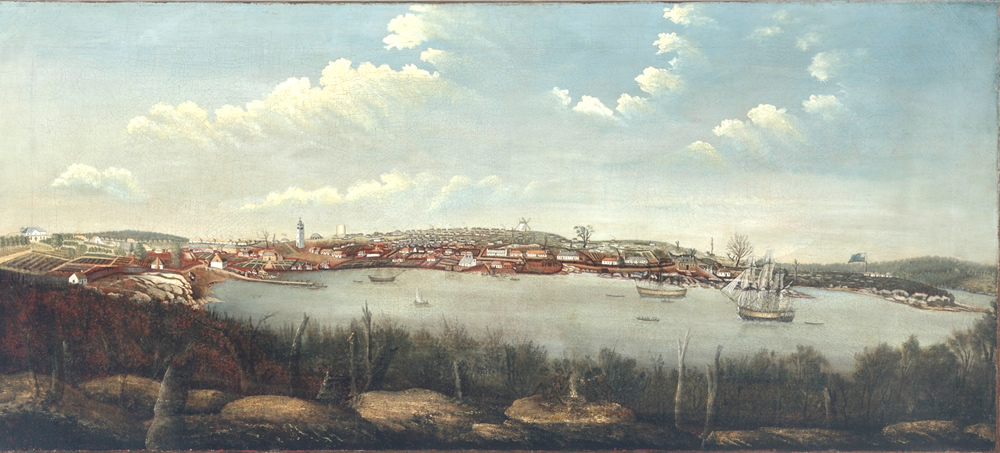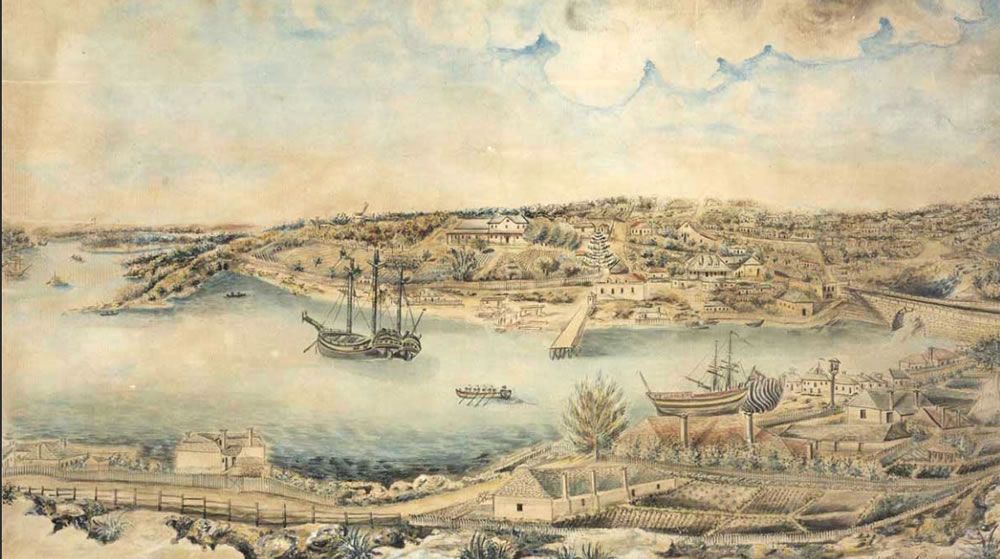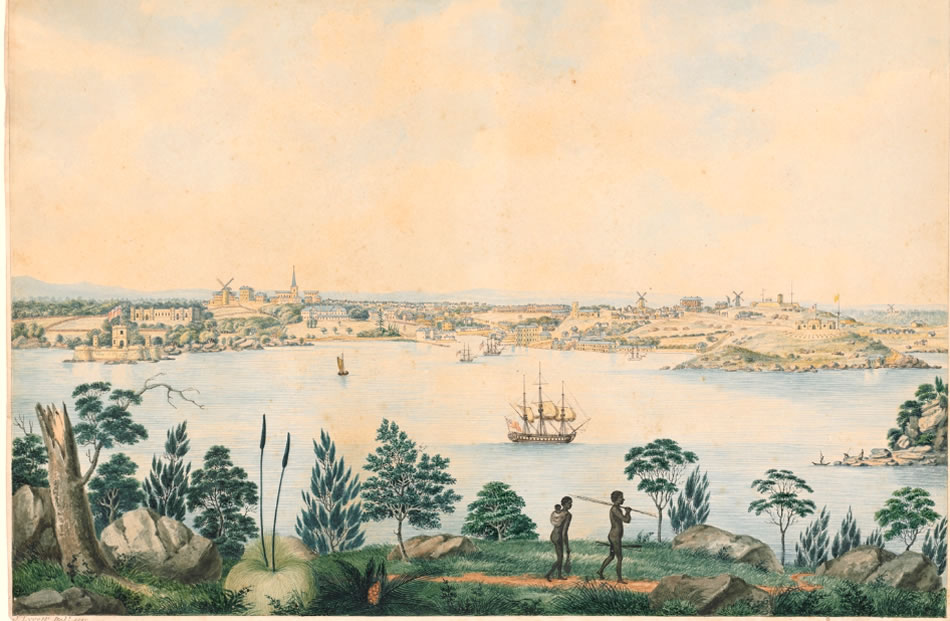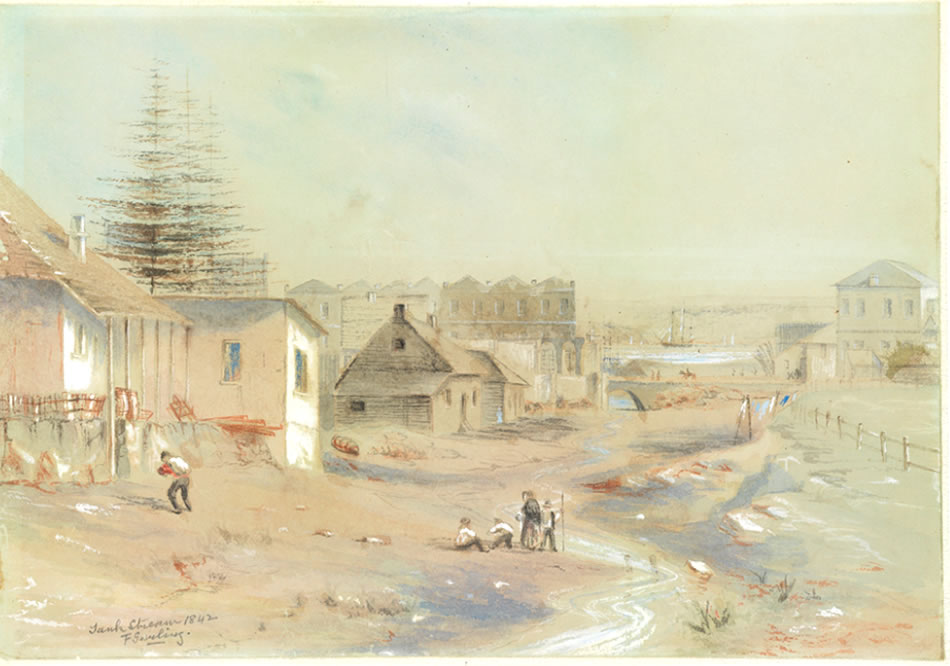The WEST FAMILY
SYDNEY TOWN
On 19 April 1770, the crew of HMS Endeavour, under the command of Lieutenant (later Captain) James Cook, were the first known Europeans to sight the east coast of Australia.
The British colony of New South Wales was subsequently established with the arrival of the First Fleet of 11 vessels under the command of Captain Arthur Phillip in January 1788. It consisted of over a thousand settlers, including 778 convicts (192 women and 586 men). Phillip soon decided that Botany Bay, chosen on the recommendation of Sir Joseph Banks, who had accompanied James Cook in 1770, was not suitable, since it had poor soil, no secure anchorage and no reliable water source. A few days after arrival at Botany Bay the fleet moved to the more suitable Port Jackson where a settlement was established at Sydney Cove on 26 January 1788. The colony was formally proclaimed by Governor Phillip on 7 February 1788 at Sydney. Sydney Cove offered a fresh water supply and Port Jackson a safe harbour, which Phillip described as, 'being without exception the finest Harbour in the World.
The First Fleet saw the first convict ships arrive in Australia in January 1788, and the last convict ship, Hougoumont, arrived in Western Australia in 1868. Over the 80 years of transportation, between 1788 and 1868, 608 convict ships transported more than 162,000 convicts to Australia.
Thomas West arrived at Sydney Town on 10th June, 1801. The colony had been struggling since 1788 when the first convicts arrived.

Sydney Cove, 1795 looking West.

Sydney Town, 1801 looking East with the Tank Stream centre right.

Sydney Cove from the West, 1803
Sydney Town in 1801 was mostly a settlement of huts with there associated vegetable gardens. The population had reached 2,000.
THE singular and distant settlement of Sydney was in the years 1800-3 a most picturesque little seaside town lying between two well wooded hills, a rivulet running down the centre of the valley. This stream was crossed by a wooden bridge, and solid stone causeway; it then flowed into the bay beyond. The town spread from Macquarie-street to Miller's Point in a scattered irregular way, Brickfield Hill bounding it on the south side, beyond which stretched marshland, bush, and sand hills.
Woolloomooloo was a forest of thick scrub and trees, with here and there a clearing, where some adventurous settler had started a farm, with great toil and anxiety, for it was so far from the town, and desperate convicts and savage natives who dwelt round the shores committed terrible ravages at times, killing the settlers, and stealing all they could find, while the soldiers were powerless to avenge them, for the impenetrable bush was a perfect hiding place.
Mr. Palmer lived at 'Walamoula,' as it was then called, in a fine house and grounds, parts of which, I believe, still are to be seen. On the sides of the various hills brick kilns were to be found, for the red soil was very well adapted to brick-making, and the old buildings still to be seen in Sydney prove that they can stand wear and tear without a crumble or crack.
Darling Harbour was known as Cockle Bay, and but little used, as it was considered shallow and unsheltered, and lay absolutely outside the civilised community; the wilds surrounded the shores (where Balmain now is), with here and there smoke, telling of natives' camp fires.
Dense scrub bordered the treacherous marsh between the water and Brickfield Hill, where the tiny hamlet of scattered cottages stood on the verge of the inland wilderness. A few ships put into Cockle Bay for shelter, and light repairs, but there was absolutely no communication with Sydney, the rocky scrub land, marshes, and rugged hills not even having a goat path over them. It was not until about thirty years later that a good road was made between Sydney Cove and Cockle Bay (Darling Harbour), when the Argyle Cut was begun, and thought to be a gigantic undertaking.
The North Shore was, in 1802, bush primeval, a tribe of aboriginals inhabiting Milson's Point, who encouraged picnickers to come over for a few hours, even going so far as to dance for them in return for rum, gay clothes, etc. Many a Saturday afternoon and Sunday were spent in this way at the Rocky Point and Lavender Bay. It was one of the sights of Sydney to see corroborees, and queer native ceremonies, with a certain amount of risk added to the pleasure. Sometimes the Governor went, too, and magnificent were the costumes, or rather skins, of the aborigines on these occasions, as it always meant a donation that kept them from hungering for days.
Circular Quay, or Sydney Cove, as it was then called, was an irregular bay, with several wharves jutting out from the beach. The tide ran up as far as the present Hunter-street, and met the main stream that watered the valley; the immediate surroundings were very marshy and unhealthy. In the cove all the ships lay at anchor, the objects of deep interest to all ashore, for it was often many months since supplies or letters had been received. In the evenings, and on spare afternoons the respectable townsfolk spent hours inspecting the ships at the wharves talking to the sailors, and watching the unloading. Ships came from all ports — China, Peru, Java, N. America, India, London, Otaheite, etc. — so that there was considerable information to be gained. Of course, the shiploads of convicts went on arriving as a matter of course, and thousands poured into the settlement, but their coming was not of so deep interest as the arrival of a cargo of sheep, pigs, or clothing. Provisions got so scarce that ships were dispatched to Otaheite, and the Friendly and Society Islands for food, good supplies of pork returning.
On the west side the Governor's garden takes up all the space, and the house stands a little above the shore line, a fine house for the days, though I believe the Governor grumbled at the draughts through the cracks. Bennelong's Point (now Fort Macquarie) was still a camping ground for the blacks, and many a corroboree has been danced there. Quite near this same point were to be found the remains of a salt pit, where, in 1797, some Americans had been allowed to settle to prepare salt for use in the colony.

Sydney Cove from North shore, 1824

Tank Stream running to Sydney Cove (Circular Quay), 1839
Home ...Prologue....Sydney...Thomas....West's ...Arthur ...Keith ...Jean ...Contact Me